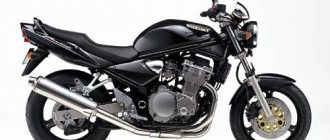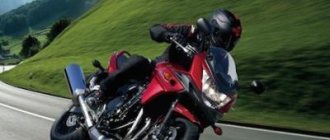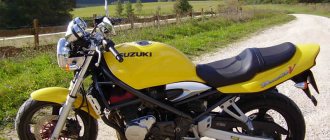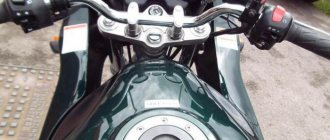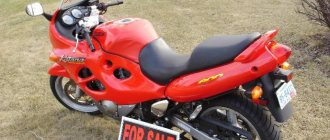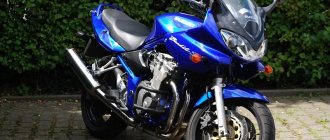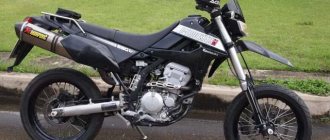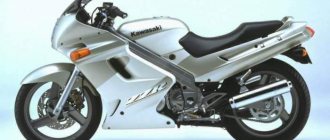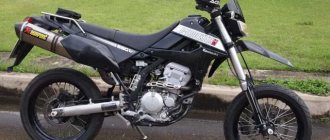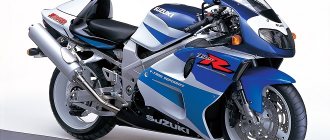The new model of the road motorcycle "Suzuki Bandit 600" was first presented to the public in 1995. She became the eldest in the GSF line. Having some common features with its predecessor, the Suzuki Bandit 400, the 600 was radically different from it. The main feature was the engine, which migrated from the Suzuki Katana, which at one time inherited it from an even older version - the GSX-R 750. Of course, the power unit underwent modernization, which resulted in a power of 77 hp. With. and 54 Nm of torque.
Other features of the Suzuki Bandit 600 include a steel duplex frame, laconic suspension in the form of a conventional telescopic fork and monoshock absorber, as well as a 6-speed gearbox.
Difficult character
It’s not in vain that even the advertising campaign reflects the connection to gangster romance, which is diligently hinted at by both the line’s designers and marketers developing advertising for the Suzuki Bandit-600 motorcycle. Photos showing the bike behind bars, and even with a weight fastened to the rear wheel, spread all over the world.
In general, neither the concept, nor the marketing campaign, nor any special performance characteristics in any way promote a criminal lifestyle and in no way contribute to it. Rather, the attachment to this image is more connected with daring, the desire for freedom, free impulses, road romance - in a word, with everything that one way or another characterizes the worldview of every biker.
Appearance
The appearance of the bike matches the name. Its headlights, surrounded by plastic fairing, evoke associations with concentrated eyes visible through the slit of a balaclava.
By the way, not all models are equipped with a fairing. "Suzuki Bandit 600" was originally produced in two versions:
- GSF 600N - without fairing.
- GSF 600S - with fairing.
Otherwise, both versions are absolutely identical. They were distinguished only by the design of the “face”. The following photo allows you to verify this.
It is interesting that the Suzuki Bandit 600 motorcycle, the characteristics of which fully correspond to the definition of “classic”, also has clear features of a naked bike. They are expressed in obvious layout features. And the arguments for a classic start with the archaic air-oil engine and dual rear shock absorbers and end with the shape. Many experts considered this to be a flaw of the manufacturer, because from such a layout buyers expected much greater sporting agility, and not regularity. By the way, this became the impetus for the creation of the 650th version of “Bandit” in 2005, which replaced the “six hundredth” brother.
History of modifications
- 1992 – start of production of the first models with an engine power of 98 hp. With.
- 1997 - the plastic covering of the motorcycle is changed, the weight is reduced by more than 30 kg, and a new engine is installed.
- 2001 - power increases to 123 hp. s., the weight is reduced by 8 kg, and the appearance changes again.
- 2004 - an inverted adjustable telescopic fork, new suspension (rear) and brakes are installed on the model.
- 2006 - the gsxr 600 gets a completely new engine.
- 2008 - plastic and fuel tank design, as well as other changes.
- 2011 – the motorcycle’s dashboard is updated, the weight loss is 4 kg, and a new fork with sports calipers appears.
Pages of history
Serial production and sales of the Suzuki GSF 600 Bandit started back in 1995. A year later, the S version was released - with a fairing. In 1999, the bike received a new rear shock absorber with preload and adjustable compression. The year 2000 was marked by many major updates. The Suzuki Bandit 600 has new plastic, a more modern front fairing, an upgraded carburetor with a throttle sensor, electrics, an additional air filter and brake calipers from Nissin. The capacity of the fuel tank has also increased - up to 20 liters. Thanks to carburetors, the maximum power increased to 80 hp. With. Since 2002, the model has included a fuel level sensor as standard. The fairing has also changed: its lines have become smoother.
A Brief History of the Suzuki Bandit
1989 - creation of bikes by Suzuki with an engine capacity of 250-400 cm3 under the hooligan name “Bandit”.
This was Honda's clearest response to their chamberlains.
1990 - release of a modified version of Bandit with a beautiful gargrot (fairing) in the style of Cafe Racer . Otherwise, the year passed without any major updates.
1991 - the first serious modernization of the technical part of the autoback: a change in valve timing and, accordingly, the acquisition of two engines by the neck .
1993 - the “Japanese” was limited in power with a cubic capacity of up to 400 cm3, 53 horsepower and a speed of up to 180 km/h, and thus the Suzuki Bandit 400 motorcycle appeared.
1995 is a truly new era in the Bandit family .
Intensive orientation of the motor market towards the Western vector (Europe and America) and, as a result, the release of the 600 cc version of the Suzuki Bandit with a modernized chassis, shortened by 20 mm (from 1430 mm to 1410 mm) and the replacement of the steel pendulum with an aluminum one, which had a positive effect on the weight of the neck , making it significantly easier.
1996 - further improvement of the Bandit and the appearance of the largest "bully" Suzuki GSF , which added to all its advantages a perfectly balanced engine, reinforced suspension and a rich instrument panel with a fuel gauge on it.
1997 - the next stage of modernization of the Suzuki Bandit and, as a result, cosmetic restyling of the autoback, a nice “mini-bikini” fairing.
1999 - the 600 Suzuki Bandit is updated with a monoshock absorber.
2000 - complete transformation of the Suzuki Bandit GSF 600: a different shape of the bike, changed chassis dimensions, new suspensions, a carburetor with a throttle position sensor, a large gasoline tank and a second fuel filter.
In addition, an ergonomic dashboard has appeared. Fairing completely modernized beyond recognition.
Subsequent experiments on the “Japanese” were insignificant and Suzuki manufacturers have not yet been able to offer anything more original than what was previously created.
However, with all this, Bandit still provides strong competition to the world's famous motorcycle monsters.
TTX
The first thing a potential buyer of a Suzuki Bandit 600 motorcycle will decide to familiarize themselves with is the technical specifications.
| Full model name | Suzuki GSF 600 Bandit |
| Type | Road, naked |
| Years of production | 1995-2004 |
| Motor | Inline, 4-cylinder, 4-stroke |
| Volume | 599 cm3 |
| Frame | Tubular, steel |
| Fuel supply | Carburetor |
| Tank | 20 l (before 2000 - 19 l) |
| Ignition | Digital |
| Power (max.) | 80 l. With. |
| KP | 6-speed |
| Acceleration to hundreds | 4.1 sec. |
| Speed (max.) | 195 km/h |
| Dry weight | 204 kg |
Review of the Suzuki GSF 600 Bandit motorcycle
In general, there are no complaints about him. The soft suspension is very pleasant; it absorbs the unevenness of our roads well. In the city, you don’t have to turn the engine in traffic, the traction is smooth throughout the entire range. In a traffic jam you can roll in second gear, practically at idle, there is enough traction. The box is soft and clear. If you don’t turn the engine, it will “eat” 6-6.5 liters, and with aggressive driving it may not choke on even 12 liters “per hundred”. As for the braking distance, it is really long; I would like to have more progressive deceleration dynamics. With the windshield it’s comfortable up to 170, and then you need to “bite” the tank cap... The motorcycle doesn’t have enough stars in the sky, but as a bike for every day, it’s what you need. In the heat he doesn’t feel very good, he gets warm. As for service... I changed the oil and filter myself, nothing complicated, almost everything can be reached without dismantling the floor of the motorcycle... I was pleased with the replacement of spark plugs, it took 10 minutes, and this without removing the tank... But in general, it is gentle and gentle.
My first motorcycle after Izh and Java. The first trip - I was blown away by the feeling of power in the coming weeks, months, I was also very surprised by the speed, the reluctance to jump off curbs, and the reluctance to drive on a country road (road tires plus weight). The ergonomics are excellent (height 189, weight 100), comfortable seat, steering wheel, footpegs, levers do not require getting used to after Russian motorcycles. The Suzuki GSF 600 Bandit engine pulls from 2000 to 12000 with pick-up in the region of 6500-7000. 6th - working city with 70-80 km/h, I think it could be longer. For me, cruising speed on the highway is 140 km/h, consumption from 6 liters 100-120 highway, up to 10 liters, on average about 7.5 liters. The maximum speed is about 220, I think more is possible if the rider is smaller in size. I can handle any kind of car alone, with two people it’s heavier, the 400s are resting (I’ve heard a lot of stories, but either I haven’t come across any good ones, or they’re just fables). It easily dials 180-200, but beyond that it’s a bit difficult. There are enough brakes, sometimes the cars are surprised. The suspension is a little soft, I realized after driving the Fire, there is a sway in corners, especially if with a passenger. Maneuverable, like any “classic”, although the weight of more than 200 kg is felt (but on the highway 200 km/h is like on rails). The seat on the Suzuki GSF 600 Bandit is wide and set low, which allows you to stand/move calmly in traffic jams. Consumes 92 gasoline and semi-synthetics. Advantages: easy to learn. Friendly. Convenient for passengers. Gives you the opportunity to feel the speed over 200. Disadvantages: fuel consumption.
I myself have such a motorcycle from 2001. In terms of speed: according to the navigator, it is very difficult to accelerate the Suzuki GSF 600 Bandit 200 km. It's easier on the speedometer. Especially if you know that he lies from 2 to 5 percent. Plus, sometimes the front sprocket costs less. It also affects the speedometer readings. In terms of consumption, the Suzuki GSF 600 Bandit can consume 5, or maybe 10 liters per 100 km. The lack of a fuel gauge is annoying. Because I am a lover of forests and rivers, so I overheated it a couple of times. It overheats readily. Especially in deep sand, or slipping in mud. The motorcycle is not for such conditions, as he declares at the first opportunity. Comfortable speed on the S version for me is about 110-120 km/h. You can do 130, but it’s unpleasant to drive far - it blows away. Still, the wind protection is not up to par, and the bike itself is not positioned for long trips. Overall the motorcycle is utilitarian and successful. In the city and near the countryside - that’s it. I think I will have the Suzuki GSF 600 Bandit for a long time. Good luck to all.
The motorcycle is very stable on the road, “tenacious”. Very dynamic and resilient. Suspension with adjustable rear spring preload. On mine the spring is very soft. On the one hand, this is bad for cornering and high speeds, on the other hand, the motorcycle can jump over bumps if you “properly ask” it to do so. I've gotten used to the soft suspension and now I don't want to change anything (the running boards are all fucking worn out on the asphalt anyway). Dynamic acceleration leaves no chance for any four-wheeled vehicle, and the motorcycle is not inclined to rear up “from the gas”. Which is very good for aggressive driving (but sometimes it still gets up, so be careful). If you want to lift it, it’s easy to do it at medium speeds by making a “pitch”, or slipping the clutch in first gear. On the second you need to do both.
Having installed a cross steering wheel, I corrected the landing so that you can ride without getting tired. The motorcycle is very good (or at least not bad) not on asphalt. I managed to accelerate it to 130-140 on dirt roads, and up to 100-120 on a sandy beach along the surf. True, it does not take turns very well (due to road tires) and does not like the “washboard” because of the small suspension travel. We drove through forest paths and other wooded areas many times. There are only 2 points that need to be monitored - the engine temperature (you can’t ride slowly for a long time) and not to break the mufflers, which are the lowest point in the motorcycle.
For this very reason, it is not advisable to drive off curbs; you should jump off them. Rails, speed bumps, etc. easily jump over at the desired speed.
NOW for beginners:
Feel free to buy the Bandit 600. All the danger lies in your heads, and not in the cubic capacity of the motorcycle. At engine speeds up to 6500, this is a normal road bike without jerks or mind-blowing acceleration. It's very manageable (I took my license on it). Of course, the traction even at such speeds is still much stronger than that of any car, but all motorcycles are dynamic. But this will teach you to carefully operate the controls. The motorcycle forgives a lot of mistakes, but it won’t let you cheat. In addition, as your skills become stronger, you will spontaneously unscrew the handle more and more. You won't need to change your bike after a season once you've gotten used to 250cc or 400cc. At rpm above 8000, the Bandit fully lives up to its name.
Purpose
Beneath the typical naked exterior lies a sporty soul. Of course, first of all, the Suzuki Bandit 600 is intended for driving around the city and its environs. This model is most often chosen by residents of large cities who are accustomed to the fast pace of life. Conceived as a maneuverable vehicle for the street, it also performs well outside the city. Of course, too hilly or swampy terrain is too tough for him, and what on earth did he forget there? For off-road there are enduro and touring. But for those who like to test their strength in high-speed races, “Bandit 600” can simply be a dream come true.
He behaves quite tolerably on long journeys. It's silly to compare its comfort level to a cruiser. However, a trip to a neighboring city will not bring any significant inconvenience to either the pilot or the passenger. The sporty shape of the saddle will, of course, force you to take rests and stretch your stiff muscles. But, on the other hand, a frisky high-speed engine will significantly reduce the time required to cover the distance. An imposing cruiser will never keep up with the Japanese “Bandit”!
Weak sides
It is worth mentioning the disadvantages of the Suzuki Bandit 600 model. Owner reviews often indicate the following:
- After a fall, the fork legs may become deformed.
- The engine is prone to overheating in hot weather, this is especially noticeable in city traffic jams.
- The plastic fairing is not very reliable. Once you drop a bike on it, it cracks and bends.
- After approximately 20-30 thousand kilometers, the resource of the rear shock absorber comes to an end.
- It is difficult to feel the moment of wheel locking with the rear brake.
However, the same motorcycle owners write that all the bike’s problems can be solved. This is greatly facilitated by the wide network of Suzuki service centers, the availability of spare parts, and ample opportunities for tuning.
Advantages and disadvantages of the Suzuki GSX 600
This model has a number of advantages that have led to great demand in many countries around the world:
- Reliable and effective brakes.
- Impressive power of 126 hp. With.
- The weight of the motorcycle is small for its class.
- Comfortable seating position, which makes even long trips a joy.
- Optimally tuned responsive suspension.
- Variety of colors.
- High quality lighting fixtures.
Among the disadvantages of the model it is worth noting:
- Intolerance to poor road surfaces.
- Not suitable for beginner motorcyclists.
- Insufficiently sized windshield.
- The road is under repair.
- High fuel consumption with a small gas tank volume.
- Some parts are difficult to find.
In conclusion, it is worth saying that despite the obedience and good handling, a motorcycle should not be chosen as the first equipment. To find out in advance all the nuances of riding a Jixer 600 and its repair, you should talk with the owners of the models who have encountered all the features of the motorcycle from their own experience.
Fuel and consumables
Let's face it, the bike has absolutely average performance in terms of weight, speed, and fuel consumption. Don't expect miracles from him. Of course, a lot depends on the driving style, temperature, the weight of the pilot with passengers and luggage, the quality of the road surface and much more. On average, plan to spend about 6.5 liters for every hundred kilometers.
Don’t start the bike, take care of its technical condition, change the oil on time and try not to skimp on the quality of gasoline. All this will reduce fuel consumption, assure the owners of the “bandit”
Photo gallery
All of the above qualities make the GSF600 a reliable companion on any road, giving the pilot a feeling of reliability and confidence and not requiring the skills of a professional racer. But you can judge his external data for yourself after viewing our small photo selection.
Tuning options
The manufacturer offers many spare parts that can be installed on the Suzuki Bandit 600 optionally. Reviews from owners most often describe replacing the steering wheel, upgrading the plastic body kit and wind protection.
The fairing is often subject to tuning. This makes it possible to install additional protection on the headlight. Replacing the windshield with a larger one allows the pilot to withstand speeds above 140 km/h better and longer. Judging by the reviews, it’s not so easy with your native one.
Modernization can also affect the saddle. This is especially true for those who often carry passengers - as on most sports bikes, the original rear seat of the Bandit is quite modest.
Wide possibilities for tuning and well-established traffic for the supply of original spare parts - all this provides the opportunity for each owner to customize his favorite “horse” for himself, taking into account all tastes, requests and needs.
Specifications
Suzuki gsxr 600 (2011 release) has the following quality indicators:
| Dimensions (length; width; saddle height) | 203; 71; 113.5 cm |
| Weight (curb) | 187 kg |
| Speed | 250 km/h maximum |
| Fuel tank volume | 17 l. |
| Fuel consumption | from 6.7 to 12 liters with mixed cycle and driving style |
| Engine | 4-stroke 4-cylinder liquid cooled |
| Engine capacity | 599 cc cm |
| Start | Electric starter |
| Engine power | 126 l. With. at 13500 rpm |
| Brake system | Disc hydraulic |
| Suspensions (front; rear) | Inverted telescopic fork; pendulum with monoshock absorber |
The distinctive features of the motorcycle are a powerful engine, reliable suspension, and an effective braking system. The 600 cc engine is capable of delivering more than 120 horsepower to the motorcyclist, accelerating the vehicle to 250 km/h. Despite the fact that the model is more intended for racing, it has also found its application in urban environments. Small dimensions and weight made it possible to quickly move between the aisles of endless traffic jams. Disc brakes improve the handling of the motorcycle, giving the rider confidence.
The fuel tank measures 17 liters and does not always meet the owners’ travel expectations. For example, when driving quickly in a mixed cycle, a full tank lasts for 250–300 km, which significantly reduces the chances of long trips. The aggressive and ergonomic shape of the motorcycle combined with interesting colored plastic makes the model memorable and impressive.
